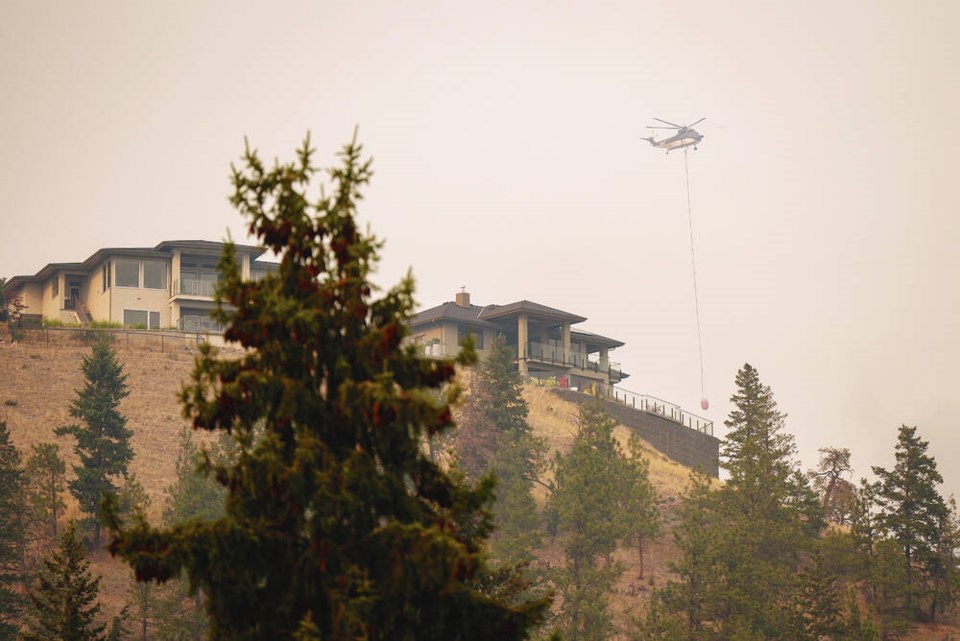A few days of cooler temperatures and some rain lessened the wildfire pressure in the Central Okanagan and a few other areas of the province, but none of us are out of the woods.
The MacDougall Creek fire continues to burn, as does the Bush Creek East fire.
As has been reported here and elsewhere, this summer in B.C. has been spectacularly bad for fire. Almost every area of the province has been affected directly.
From Osoyoos on the Washington border to the Little Blue River region near the Yukon Border and from Vancouver Island eastward to Sparwood, we’ve all seen images of B.C. burning up.
Although evacuation orders have been lifted in some areas, elsewhere, the stress is building.
But at the end of this season, every one of us should be thinking about how our communities are designed and built to lessen the hazard and the risk of catastrophic wildfire.
It’s not as if this is the first time we’ve gone through this in the past eight years. And if the climate scientists are correct — and all the science says they are — we can expect worse fires in years to come.
Our U.S. neighbours have spent some 20 years assessing, testing and determining best practices for wildfire-resistant community and building design.
They’ve found, for example, the communities most resistant to wildfire are the more densely populated infill communities within larger towns or in cities — ones like those common in older developments in this region, where large residential city lots are subdivided into smaller, tighter lots.
Such communities tend to be well buffered from the messy tinder-abundant wildlands found further out. They also have ready access to the water and fire services that facilitate firefighting.
If conditions align and all systems fail, they’ll burn, but the required conditions for out-of-control wildfire rarely align for these communities.
Communities with lower housing density and larger numbers of small, isolated clusters of development amid rural or wildland areas have generally been found to have the highest predicted fire risk to the largest proportion of structures.
These are exactly the kinds of community we see being built so often farther up the peninsula or out toward Sooke, in the Lower Mainland, and in the hills ringing the protected farmland around Kelowna.
Build those communities on a ridge with a fantastic view, and the fire risk worsens. Fire flames upwards, after all.
Wildfire that starts at the bottom of a hill will climb it, given fuel, oxygen and heat. We saw many dramatic and traumatic photos this summer of fires sweeping up and over hilltops towards homes and communities.
Distance and gradient from a town’s main water supply means gravity must be overcome with electricity-run pumps to bring water to fight fires. If the electrical service is above ground, it’s vulnerable, and so is the water supply.
Because of this, municipalities often require that critical power infrastructure be routed underground, which increases costs. Human-made hilltop water reservoirs, like those found at the top of Cordova Bay Ridge here in Victoria, may also be required as part of subdivision plans.
Limited roads into hillside communities restrict both firefighter access and resident escape routes, increasing hazards and risks further.
Buildings within wildfire-vulnerable areas can also be designed and constructed to limit wildfire spread. For example, nearly 40 per cent of homes designed to resist wildfire and built after 1996 survived the 2018 Paradise, California fire, compared to 11 per cent of older homes in that community.
Researchers have found that complex roofs are more fire-hazardous. Edges, including skylight edges, and gutters can collect debris and embers. Gable end vents are vulnerable to ember entry from wind. Simple roofs, covered gutters, and finely screened vents to keep embers out are solutions.
Fire-resistant roofing, siding, fencing, decking and outbuilding materials are also important considerations, as are landscape design and maintenance.
For that matter, the design and materials used for neighbours’ houses and yards also affect a home’s risk to wildfire.
Which just goes to show that when designing communities in and near wildlands to reduce wildfire risk, the community approach is critical.
This is hardly a comprehensive list of development, design and construction choices that can be employed to lessen wildfire risk in communities. It does, however, show that opportunities exist.
Given the fire forecast for future seasons, it would be worth taking a hard look at them.
>>> To comment on this article, write a letter to the editor: [email protected]



